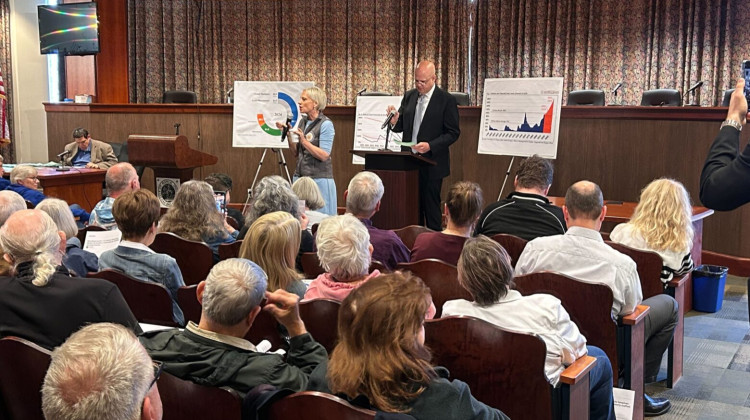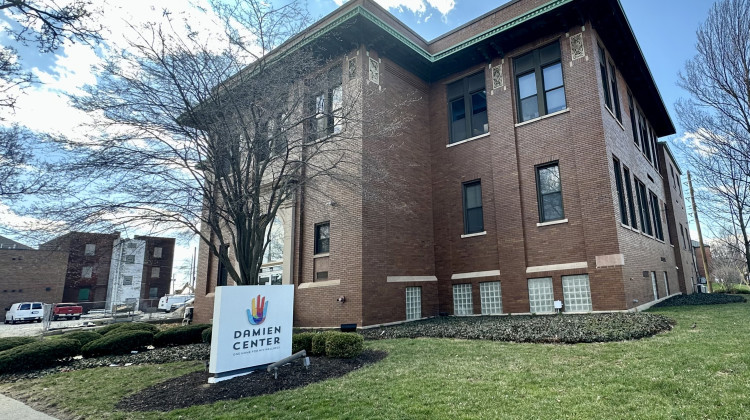
The biggest change to Indiana’s primaries was opening up vote-by-mail to all registered voters.
Stephanie Wiechmann/IPRIndiana residents must be registered to vote 29 days before each election. What do you need on Election Day? What do you need to register to vote? Can you vote if you’re homeless?
If there’s a question we haven’t answered, let us know in the box below. And for more reporting on the 2020 election and to tell us what information you’re looking for, text “elections” to 73224 to join the Indiana 2020 Two-Way. We’ll text you once per week with either a question or to share reporting based on what we received from previous questions.
READ MORE: Can I Go For A Walk? Here's What The Updated 'Stay-At-Home' Order Really Does
Join the conversation and sign up for the Indiana 2020 Two-Way. Text "elections" to 73224. Your comments and questions in response to our weekly text help us find the answers you need on COVID-19 and the 2020 election.
LEE MAS: ¿Puedo Salir A Caminar? Esto Es Lo Que Significa Una Orden De Permanecer En Casa
How has Indiana changed the primary election in response to the COVID-19 pandemic?
The biggest change to Indiana’s primaries was opening up vote-by-mail to all registered voters. Indiana is among the one-third of states that require a reason for vote-by-mail. But in light of the pandemic, the state is encouraging Hoosiers to vote-by-mail and working to make it easier to do so. Before the pandemic, outside of a few counties that allowed fax or email requests for vote-by-mail ballots, voters had to mail a request to the election board. The state has built an online request system through the Secretary of State’s website.
The other big change: absentee in-person voting, or early voting. Indiana usually allows early voting at county election board offices 28 days leading up to an election. But this year, the Secretary of State’s office announced it will limit it to eight days.
Who is eligible to vote in Indiana?
There are a few qualifications to vote in Indiana. First and foremost, you must be both a U.S. citizen and a resident of Indiana. Additionally, you must be 18 years old on or before Election Day – which means 17-year-olds can vote in primaries as long as they’re 18 before Nov. 3, 2020.
People who are currently in prison after being convicted of a crime cannot vote in Indiana. But their voting rights are restored upon release. And you have to have lived in the precinct you’re voting in for at least 30 days before the election.
Finally, you have to be registered to vote.
How do you register to vote?
The easiest way: go to IndianaVoters.com. The Indiana Secretary of State runs the site, and allows you to register to vote, update address information, check your registration and find your polling place on this website.
But you also must have a valid Indiana Driver’s License or Indiana State Identification Card.
You can register to vote by mail or in-person by filling out a voter registration form. Indiana residents can register to vote without a driver’s license or Indiana State Identification Card – but, because of Indiana’s voter ID laws, you’ll have to have a legal identification card issued by the U.S. government or the state of Indiana on Election Day.
Certain military and overseas voters have extended registration deadlines. All that information is available on the Indiana Secretary of State’s website.
How do I request a ballot to vote by mail?
Once you’ve registered to vote, you may request an absentee-by-mail ballot from your county election board. The Indiana Secretary of State’s office has developed an online portal to request a ballot.
To do so, after you have registered to vote, go to IndianaVoters.com:
- Select “Visit My Voter Portal”
- Fill out the details on the pop up box (first and last name, data of birth, and county)
- Once you’re in your voter portal, on the left hand side, select “Absentee Voting” then “Vote-By-Mail”
- Then fill out the form
- INFORMATION OF ABSENTEE BALLOT APPLICANT
- Fill out the form – you should just need to provide the last four digits of your Social Security Number.
- Confirm your current address
- Confirm if your name has changed
- ABSENTEE BALLOT MAILING ADDRESS
- Confirm if your mailing address is the same as the address you’re registered to. If it’s not, you’ll be asked to fill out that address.
- PRIMARY ELECTION ONLY
- For primary elections in Indiana, while you are not required to register with a political party, you do have to request one party’s ballot. If your ballot includes a public question, you may request a ballot for just that question.
- Once you make that selection, there are two more questions to answer. The first asking if you received help filling out the application, and the second acts as a signature, confirming the information is correct and you are not committing voter fraud.
Absentee-by-mail voters are not required to show photo identification. County boards must receive absentee-by-mail applications by May 21, 2020 at 11:59 p.m. – and the application can be mailed, emailed, or hand delivered to county election boards.
Now, how do I vote by mail?
After requesting your absentee-by-mail ballot, you must fill it out and mail it to the county election board’s office.
But also keep in mind: ballots are only valid if they are received by the election board before noon on June 2 – so leave plenty of time for mail to get to your election board.
Can I vote in person?
Yes. But it’s not really encouraged for voters who may be at higher risk for COVID-19. The state is limiting early in-person voting. Usually, voters are able to vote at their county election office 28 days before an election. But due to the pandemic, the state is limiting that to eight days.
If you plan to vote on Election Day, be sure to double check your polling place. You can do that on IndianaVoters.com under your Voter Portal. At the very top of the page, it lists the locations you’re able to vote on Election Day. A few counties in Indiana have vote centers, where any county resident is able to vote, no matter their address.
On Election Day, polls are open from 6 a.m. to 6 p.m. local time.
What do I need on primary or Election Day?
You need a photo ID.
Under Indiana’s 2005 voter ID law, your photo identification must meet four criteria: it must display your photo, your name (though, it doesn’t have to be a perfect match), an expiration date and either be current or have expired sometime after the date of the last General Election, and issued by the state of Indiana or the U.S. government.
There are a handful of photo IDs that fall into those categories. An Indiana driver’s license, a U.S. passport, Indiana State Identification Card, or military ID card all work. And student IDs at Indiana state colleges and universities may also work – as long as they follow the rest of the criteria. However, students at private institutions may not use student IDs for voting.
What if I’m unable to present an ID card on primary or Election Day?
If your identification card doesn’t meet criteria, you can cast a provisional ballot for the election. You have until noon, 10 days after the election to present a valid form of identification.
How do I get an Indiana State Identification Card if I don’t have a driver’s license?
Indiana’s 2005 voter ID law also included the requirement that Indiana Bureau of Motor Vehicles provide free identification cards. To obtain that card, you have to provide original copies or certified versions of documents to prove your Social Security number, identity, lawful status in the U.S., and two documents proving your Indiana residency.
How do I prepare to vote?
Go to IndianaVoters.com and select “Check my registration.” Once you log into your Voter Portal, scroll to “Who's on the Ballot.” Remember, in Indiana, while you don’t have to register with a specific party, you’ll have to select only one party’s ballot when you cast your ballot in a primary.
Also, ahead of the 2020 primary, you’ll notice all the previous Democratic candidates who have since ended their campaigns are still on the ballot. If candidates get enough signatures to be added to the ballot, even if their campaigns end, they’ll still be there.
What rights do I have as a voter?
Short answer: a lot. If you meet the criteria for voting in Indiana, you have the right to fair and free elections.
The Indiana Secretary of State has a one-page document in English and Spanish for who you need to call if you’re concerned about your voting place. If you feel your rights have been violated or you’re concerned about voter fraud there are a few resources you can contact.
Indiana Secretary of State’s Office
(866)-IN-1-VOTE (866-461-8683)
They’ll have staff on hand for phone calls from 6 a.m. to 7 p.m. Eastern.
Indiana Disability Rights
Voice (317) 722-5555
Toll Free (800) 622-4845
Text Telephone (TTY) (800) 838-1131
Indiana Election Division
Direct (317) 232-3939
Toll Free (800) 622-4941
How do I make sure my voting place is accessible?
The Help America Vote Act of 2002 requires each polling place has at least one accessible voting machine, in addition to making the facility accessible.
Voters with physical disabilities may seek assistance from poll workers (one from each political party). You’re also able to designate a friend or relative to assist you during voting – but they must complete an Affidavit of Voter Assistance at the Polls. That’s available at the polling station, before entering the voting booth.
If there is an issue with accessibility at your polling place, you can call the Indiana Secretary of State’s office and file an accessibility grievance form.
Can someone vote if they are housing insecure?
Short answer: yes.
People who have a non-traditional residence, like those who are homeless, or those who live in a motor home, must still provide a location sufficient to allow local election officials to place the person in a precinct. If you stay in more than one place, voter registration officials should ask you to designate the location where you usually sleep in the county.
Your best chance of registering to vote will be working with your county election board. If the place has no street address, you’ll be asked to indicate the location by drawing a map or writing a description of the location on the state’s voter registration form or federal mail-in registration form in the appropriate box.
You’ll also be asked to provide a mailing address within the county where you reside – that being said, P.O. boxes cannot establish residency.
For online voter registration, you’ll be asked to provide an intersection for your address, which county officials will use to determine your precinct.
Contact Lauren at lchapman@wfyi.org or follow her on Twitter at @laurenechapman_.
This is a rapidly evolving story, and we are working hard to bring you the most up-to-date information. However, we recommend checking the websites of the Centers for Disease Control and Prevention or the Indiana State Department of Health for the most recent numbers of COVID-19 cases.
 DONATE
DONATE





 View More Articles
View More Articles





 Support WFYI. We can't do it without you.
Support WFYI. We can't do it without you.